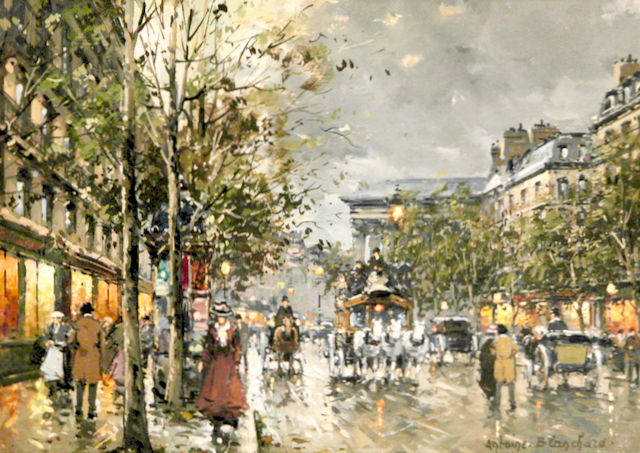"Boulevard de la Madeleine"
"Boulevard de la Madeleine"
Original Oil Painting
by Antoine Blanchard
Canvas size: 13”x 18”
Frame size: 21 1/2” x 26 1/2"
Click on photo to view full images
Antoine Blanchard
Born 1910 Paris, France
Born Marcel Masson, and son of a furniture maker of the Loire Valley near Paris, France, Antoine Blanchard was known for painting Paris scenes. While his paintings were modeled after the artist Edouard Cortes, Blanchard had his own Belle Epoque, or beautiful era image of Paris, and his paintings emphasized the beauty and romanticism of Paris in an earlier time. Blanchard’s hundreds of paintings, portraying the sights of Paris, are still admired as a legend to the art world.
The Transformation of Marcel Masson
Marcel, who exhibited artistic talent, was sent to Blois for artistic training, and later to the Ecole des Beaux-Arts, where he received education in classical art. In 1939, Masson married, and shortly thereafter, was drafted to serve in the French Army. He returned to his family and his art, during the Nazi occupation. His primary job at the time was keeping his father’s fine furniture store operating.
Marcel, his wife, and two daughters, moved to Paris to further his career in the 1940’s. He then became Antoine Blanchard: Painter of la ville des luminaries (or painter of Paris, the city of light). It was not uncommon for French artists to change their names, or to assume several names to exhibit their art work. In the late 1950’s, agents began to buy Blanchard’s paintings, to export to the United States galleries in major cities. By 1965, Antoine’s work was known an is now familiar in print.
By the 1960’s, Blanchard began developing his own style, in order to step out of Cortes’ shadow. By the 1970’s, the American market absorbed nearly all of Blanchard’s work. The majority of his work was smaller, and the paintings were sent to the United States in tubes, then unrolled, stretched, and framed by the American galleries. In 1979, Blanchard won a local art contest, held by the Cafe de la Paix owners, and of 347 artists, Blanchard won the Grand Prix du Public, or the grand prize.
Painter of la ville des lumières
Blanchard initially modeled Edouard Cortes, as a Belle Epoque painter with classical art training. Blanchard’s own style developed, using a lighter, and brighter palette of colors, and a brushstroke which was light, with small strokes, resembling calligraphy. Blanchard’s excellent use of perspective, softer pastel tones, and lighter brush touch gave his paintings a more decorative look, recalling previous impressionist artists.
Blanchard viewed Paris in a historical rear view mirror, adding his own romance. He initially collected sepia postcards of Paris, which reflected life of peace, prosperity, and beauty in Paris, as opposed to the time after World War I, in which he lived. Subjects of his paintings are the nobility chateaus of Loire Valley, the Notre Dame Cathedral, the Place Concorde the Opera, and the Arc de Triomphe, and many of the boulevards in Paris.
His paintings such as Boulevard De La Madeleine, and Les Grands Boulevards La Porte St Denis let the viewer enjoy seeing horse-drawn carriages, fashionably-dressed ladies and gents, and sidewalk cafes, depicting Paris throughout the seasons. Blanchard never sought fame as an artist, and was content to work in his studio, until his death in 1988. Blanchard’s hundreds of paintings allow the viewer to stroll along the Paris streets, window shop along the boulevards, and enjoy the beautiful scenic past of Paris.



